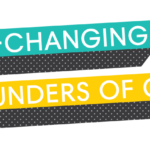This is one of my favorite stories, and I dare you to watch it without needing a tissue.
Emmet, a spunky preschooler, and Erling, a WWII veteran, sparked an unlikely friendship that involved tractor races and games of croquet. These next-door neighbors became best friends, despite an 86-year age difference. But with both neighbors moving, Erling to an assisted living facility and Emmet to a new home, these friends find out that it’s hard to say goodbye.
Although this story isn’t ours, we share the experiences of friendship, loss, and joy.
It’s through stories that we connect with the world around us—and also with ourselves.
Humans have been storytelling for thousands of years to teach important lessons and share values. And our brains love stories.
Through his research, neuroeconomist Paul Zak found that compelling and emotional stories change our brain chemistry. When we hear stories that we connect with, our brains produce higher levels of cortisol (associated with stress) and oxytocin (associated with empathy and generosity). These stories also engage with more areas of the brain and therefore are remembered longer. (Watch a video describing his research.)
Neuroscientist Uri Hasson discovered scientific evidence supporting the human connection that happens through stories; something he refers to as “neural coupling.” In one experiment, he hooked up multiple participants to an fMRI machine that monitors brain activity. Before a story was told, the participants’ brain activity was random. But once the story started, something amazing happened. The brain activity of each listener reached the deeper, higher-order parts of the brain and began to follow a pattern that remained consistent among all listeners and the storyteller; the pattern aligned with the ebbs and flows of the story itself. (Watch Hasson’s TED Talk.)
Stories connect with people at their core.
Business and stories
I spent part of my career in management at a Fortune 500 medical device company. Quarterly, we had “town hall” meetings where we’d review slides of trends, yields, and sales earnings. I left these meetings with a jumble of statistics swimming in my head as I went back to my desk—and not much more.
But annually, we’d have an event where employees would hear stories from patients themselves. This is where real connection happened. We’d hear from people that were once too tired to play with their kids or were told by doctors that they’d never be able to run again. Then we’d learn about their transformation after using our devices. How they danced all night at their nephew’s wedding or how they laced up their running shoes and finished a marathon.
After these meetings, the mood within the company changed. Employees felt valued by seeing how our work and long hours made an impact on real people.
Consumers are inundated with tweets, posts, and pop-ups from brands competing for attention. Teams are overwhelmed by metrics. Charts and statements dominate the world of business.
But whether you’re looking to build relationships with customers, share your company’s purpose, pitch an idea, or motivate employees, facts and figures just aren’t enough.
Stories are what connect us.
How to tell a great story
Leaders who can craft great stories have a powerful ability to create connections and drive change. But what makes a great story? Let’s take a look at some core principles.
Start with a purpose: Before crafting a story, a crucial first step is knowing the message you want to communicate and who you intend to receive it. Do you want to share with potential customers that you’re fighting for a cleaner planet? Are you looking to recruit talented people who want to make an impact in their work? Does your team need reassurance that failure has led to some of the world’s greatest successes?
Take time to articulate the purpose behind your story, then choose how to best communicate that message. As you build out your story, be ruthless about pruning out what doesn’t help drive the purpose forward.
Remember your audience: In order to make a connection with your story, your audience needs to somehow feel a part of it. No one wants to hear a leader brag about their personal accomplishments. But learning how perseverance and mentorship helped you through one of the biggest challenges of your career makes for a compelling story.
Likewise, customers don’t want to hear a story about how great your product or service is. Your solution is a means to help them reach their goals. Customers want to hear their story. Guide them from the problem they’re facing to a better future—maybe more time with family, freedom from stress, more money, etc.
Be real: Believe in your story. Authenticity is critical to building trust and relationships. Your audience has a keen sense for what’s real or fake. Believe in the story that you’re telling, and if you don’t, choose a different story.
Keep things simple: A little detail can add to the story, but too much can be distracting. Abide by the principle that less is more. Simplicity applies to language, too. Write and speak like you normally do. Thesauruses are great, but if you rarely use the word you’re considering, choose a different one.
Use what you know: Think of the moments when you transitioned into a new role, had a huge success, or when you reached a devastating low point. This is where you’ll find stories. It may feel difficult to share these moments with customers or your team, especially stories about failure, but by being vulnerable and open, you’re creating an opportunity for people to connect with you.
Core story elements: Motion, tension, reflection
Combining science with advice from expert storytellers, here’s a recipe for crafting a story that connects:
Motion: It could be the most mundane sequence of events, but our brains can’t help but get on the “story-train” to see where it goes. Take this example: “Yesterday I drove to the grocery store. I parked, locked my car, and made my way toward the entrance. It was a gray, foggy day.”
Yes, this is the beginning to the world’s most boring story. But, you have to admit that you’re probably at least a little interested in where this story is going. That’s what a sequence of events does—it creates motion. Obviously, if I continue with this flat story that has no plot and goes nowhere, the listener will get bored. Which is why we need the next element, tension.
Tension: Every interesting story needs to have tension or conflict to hold the listener’s attention. Expert storyteller Ira Glass of This American Life refers to tension as “raising questions,” and neuroeconomist Paul Zak found in his research that tension is key to compelling stories.
Throughout your story, continue to make people curious about what’s going to happen by building tension and raising questions. Just make sure that you continue to answer the questions you create so the listener doesn’t get confused. Let’s see if we can make my grocery run a little more interesting: “Yesterday I drove to the grocery store. I parked, locked my car, and made my way toward the entrance. It was a gray, foggy day, but up ahead something caught my eye. It was a bright orange sign taped to the glass of the entrance door.”
Again, not a literary masterpiece, but while your mind followed the motion of events, you were also introduced to some questions: What caught your eye? What does the sign say? Tension should build as a story progresses, developing into a larger problem that the main character needs to face until reaching the climax, at which point we find out whether they succeed or fail.
Reflection: This is the crux of connection. It’s where a character or the narrator reflects on what the story means. If you’re a Harry Potter fan, reflection occurs at the end of each book when Harry and Professor Dumbledore talk about what just happened; about courage, fear, vulnerability, and the ongoing battle between good and evil.
In most episodes of This American Life, Ira Glass begins with an anecdote, using the moment of reflection to cue up the show’s theme. Take a listen to this clip about a 10-year-old girl who is terrified of roller coasters and finally faces her fear:She reflects, “I am a different person than I was a minute ago.”
Stories in action
The purpose that drives you can’t be accomplished alone. It requires a community. As you try to bridge understanding, to inspire change, and to make things clearer, consider a story to create a connection. Enjoy the following collection of stories from leaders and brands. As you listen, see if you can spot the motion, tension, and reflection in the narratives.
- Best-selling author and speaker Dr. Brené Brown sits down with Oprah and shares the thing that terrifies many people: joy. Jump ahead to 3:22, where Brené shares a short story of a man she met who intentionally lived his life without too much joy or excitement in order to protect himself from disappointment and suffering.
- Released as an antidote to Black Friday, Worn Wear tells Patagonia’s brand story through the experiences of customers and the clothes they love.
- Zappos CEO Tony Hshie has created a corporate culture that thrives on autonomy and customer experience. In this clip, he shares a story about the impact one of his employees made on a customer.
- Security company McAfee created the podcast Hackable to raise awareness of threats on our personal information. Each episode starts with a dramatic reenactment of a pop-culture story before diving into the details of the topic. Take a listen to Cyber Wash.
- Gretchen Rubin hosts the popular podcast Happier with Gretchen Rubin, and every so often she’ll release mini episodes aptly named, A Little Happier. In this episode, she shares a story about waitressing and reflects on how people perceive the actions of others. Bonus episode: A Little Happier on storytelling.
- Dan Pink, best-selling author of books about work, business, and behavior, shares one of his favorite ways to pitch. He calls it “The Pixar Pitch.”





